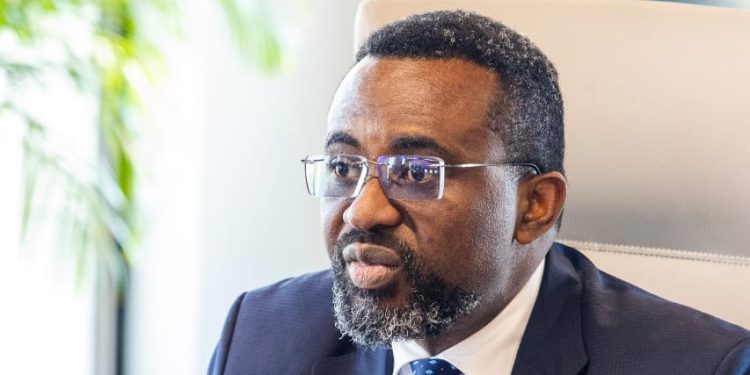The Bank of Ghana’s (BoG) Monetary Policy Committee (MPC) has delivered its most aggressive policy easing in years, slashing the benchmark policy rate by 350 basis points—from 21.5% to 18%.
The decision, announced by Governor Dr. Johnson Asiama after the MPC’s 127th meeting, comes against a backdrop of rapidly moderating inflation, strengthening macroeconomic buffers, and a renewed push to support Ghana’s fragile but improving growth recovery.
Inflation falls, policy space opens
Inflation currently stands at 8%, comfortably within the central bank’s target band.
According to the MPC, the risks that could divert inflation from its projected path have “moderated significantly,” giving policymakers room to ease monetary conditions without jeopardising the stability achieved in recent months.
Dr. Asiama emphasised that the persistently high real interest rate—now far above the inflation rate—created the right conditions for a bold cut in the policy rate.
The Committee also announced a return to the use of the 14-day bill as its main open-market operation tool, signalling a broader recalibration of liquidity management strategies as Ghana transitions from a period of tight monetary restraint to one of cautiously accommodative policy.
Lending rates already on a downward trend
The sharp reduction in the policy rate is expected to strengthen the downward trajectory already observed in commercial lending rates throughout 2025.
From a staggering 30.07% in January 2025, average lending rates have fallen steadily to 22.22% by October 2025, a decline of over seven percentage points.
Part of this decline reflects earlier policy adjustments—particularly the cut to 21.5% in September 2025—but the new 18% benchmark is likely to deepen and sustain the trend.
A key transmission channel is the Ghana Reference Rate (GRR), the base rate that guides pricing of loans across the industry.
The GRR has dropped from 29.72% in January 2025 to 17.86% in October 2025, closely mirroring the disinflation path and easing monetary conditions.
With the policy rate now at 18%, the GRR is expected to edge down even further.
Banks expected to pass on cheaper credit—but unevenly
For commercial banks, a lower policy rate reduces the cost of funds, making it cheaper to source liquidity from the central bank and lowering the interbank market rates that influence lending decisions.
This, combined with cooling inflation, reduces the premium banks must charge to protect their margins.
However, lending rates will continue to differ widely—some banks may price loans close to the GRR, while others, especially those dealing with high-risk borrowers, may charge rates as high as 39%.
Risk-based pricing remains the key determinant, shaped by portfolio quality and customer profiles.
Businesses to feel relief as borrowing costs fall
The sharp policy rate cut is a major signal to businesses, particularly those in manufacturing, agriculture, retail trade, and services—sectors long constrained by expensive credit.
Lower borrowing costs and improved cash flow
Businesses should expect a gradual fall in loan costs as banks adjust their pricing models.
For firms servicing expensive loans, refinancing becomes more attractive.
New borrowers, especially SMEs, could see borrowing costs drop by 2–4 percentage points depending on their risk profile.
Lower interest expenses will free up cash for inventory, wages, and reinvestment—critical for SMEs, which constitute more than 80% of Ghana’s enterprises.
Stronger production, hiring and domestic trade
More affordable credit encourages expansion in production and hiring.
Sectors like construction, agro-processing, logistics and ICT—highly sensitive to interest rates—could respond quickly.
Retail and wholesale businesses, burdened by high costs of importing and stocking goods, may also benefit from cheaper credit, easing pressures on prices and stabilising supply chains.
Growth outlook brightens as monetary conditions ease
With inflation under control and growth momentum returning, the timing of the policy rate cut is strategic.
The Bank of Ghana appears to be moving from crisis containment to growth support.
Demand revival and private-sector credit rebound
Lower borrowing costs increase both investment and consumption, potentially lifting GDP growth in 2026.
After years of suppressed credit expansion, banks—now operating in a more stable macro environment—may expand private-sector lending more confidently.
Reduced debt stress but some risks remain
Lower commercial lending rates improve firms’ solvency and reduce default risks, supporting overall financial sector stability.
The major risk, however, is whether disinflation will hold. External shocks such as commodity price swings or supply chain disruptions could force a policy reversal.
A shift toward pro-growth monetary strategy
The bold 350-basis-point reduction marks a decisive shift toward a pro-growth stance and signals confidence in Ghana’s macroeconomic trajectory.
As banks gradually adjust their lending rates, businesses should experience meaningful relief in financing costs.
If transmission is effective, the policy move could unlock delayed investments, support job creation, and strengthen the private sector’s role in the recovery.
But the full impact depends on banks’ willingness to pass on the lower rates, the resilience of disinflation, and fiscal discipline.
Overall, the MPC’s decision opens a new phase—one where stability and growth are expected to reinforce each other as Ghana heads into 2026.












